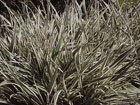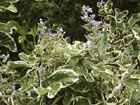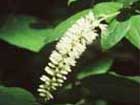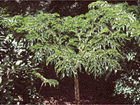Plant Profiles
Click on the first letter of the common name of the plant you wish more information about.
A | B | C | D | E | F | G | H | I | J | K | L | M | N | O | P | Q | R | S | T | U | V | W | X | Y | Z
V
- Variegated Cassava
- Variegated Flax Lily
- Variegated Vitex
- Virginia Willow
- Vitex, Variegated
- Voodoo Lily
Variegated Cassava
Scientific Name: Manihot esculenta' Variegata'
Growth Habit: A vase-shaped evergreen shrubby perennial growing to 8 feet tall and equally as wide. The leaves are variegated and compound, growing to 10 inches in diameter with up to seven leaflets.
Light: Grow in full sun to light shade.
Feedings: Apply a light feeding with a general garden fertilizer monthly March through November.
Water Needs: Drought tolerant; grows best with weekly waterings.
Ease of Culture: Easy.
Propagation: Start plants from stem cuttings.
Hardiness: Tender; plants are heavily damaged by freezes but usually grow back from buds near the ground.
Major Problems: Chewing insects may feed on the foliage but seldom need control. Plant in a well-drained soil to avoid root-rot problems.
Pruning: Cassava plants form well-branched shrubs that can grow quite large for small landscapes. Keep confined to the space available by removing or restricting branches. Also remove cold damage and control growth as needed during late February or March.
Uses: Cassava plants of the solid green leaf varieties, frequently called yucca, sweet potato trees and tapioca plants, are often used for food. Large roots are harvested after about a year of growth and specially prepared for cooking to remove toxic prussic acid. The variegated cassava is used as an ornamental, often featured as an accent among solid green shrubs or as a backdrop for gardens. The cassava can be grown in a large container for patio display.
Florida Native: No; native to Brazil.

Variegated Flax Lily
Scientific Name: Dianella tasmanica' Variegata'
Growth Habit: An evergreen upright perennial forming clumps of tightly packed foliage that produces plants to 2 feet tall and wide. The variegated selection has a white margin along the bright green lancelike leaves growing to 2 feet long and 2 inches wide.
Light: Tolerates full sun but grows best in filtered-sun to shady locations.
Feedings: Apply a general garden fertilizer once monthly in March, June and October.
Water Needs: Drought tolerant; grows best with weekly waterings during the hot, dry weather.
Ease of Culture: Easy.
Propagation: Start plants by dividing established clumps.
Hardiness: Hardy; outer leaf portions might be damaged by severe freezes but can be pruned when growth resumes in early spring.
Major Problems: Fungal leaf spots occasionally might affect plants during periods of unfavorable growth but seldom need control. Scale insects also might affect the foliage but can be controlled with natural insecticides.
Pruning: Remove cold-damaged foliage in late February. Prune declining leaves and flower stems as needed throughout the growing season.
Uses: Plant clusters as a ground cover or accent to create spots of interest. Another popular use is in border plantings along walkways and formal beds. Plants also are added to container gardens for patio, entrance and balcony displays. Long stems of small starlike blue flowers form above the foliage May through November to produce contrasting color. Leaves and stems of blossoms can be cut and added to bouquets.
Florida Native: No; native to Australia.

Variegated Vitex
Scientific Name: Vitex trifolia 'Variegata'
Growth Habit: An irregular to rounded evergreen shrub to small tree growing to 10 feet tall and wide. The leaves are three-parted and green with a white margin, and they grow to 3 inches long and wide.
Light: Plant in full sun to lightly shaded locations.
Feedings: Lightly apply a general garden fertilizer once monthly in March, June and September when needed to encourage growth.
Water Needs: Keep moist until the roots become established in the surrounding soil. Thereafter, the plants are considered drought tolerant but grow best with waterings every other week during periods of hot, dry weather.
Ease of Culture: Easy.
Propagation: Start plants from cuttings.
Hardiness: Medium; often damaged by freezes but usually grows back from stems near the ground.
Major Problems: Grow in a well-drained soil to avoid root rot problems. Scale insects may affect the foliage and stems. Apply an oil spray if needed to prevent damage.
Pruning: A rapid-growing plant that may need frequent pruning to keep in bounds and to remain a compact shrub. At the end of winter, remove cold-damaged portions and reshape to the desired form.
Uses: Plant in an obvious location to enjoy the variegated foliage and blue to lavender blossoms May through August. Vitex plantings may be used as a hedge, a view barrier or a backdrop for other shrub and flower plantings. Many gardeners like to keep a plant in a large container to set on the patio or near an entrance to train as a small tree.
Florida Native: No; native to Asia and Australia.

Virginia Willow
Scientific Name: Itea virginica
Growth Habit: A rounded, loosely branched deciduous shrub growing to 6 feet tall and often as wide. Plants produce dark green elliptic leaves up to 4 inches long and 2 inches wide.
Light: Grows in full sun to light shade.
Feedings: Apply a light scattering of a general garden fertilizer in March, June and August.
Water Needs: Drought tolerant; grows best in moist soils with weekly waterings.
Ease of Culture: Easy.
Propagation: Start new plants from seed or cuttings. Offshoots from older plants can be dug and transplanted.
Hardiness: Hardy.
Major Problems: Leaves are occasional food for chewing insects, but control seldom is needed. Plantings reproduce by underground roots that develop shoots that may invade nearby shrubs and flower beds. Control may be needed to remove these unwanted shoots.
Pruning: Plants tend to be open in growth habit, but pruning back the tips of the limbs after spring flowering can help encourage branching and a dense shrub. Gardeners also may have to remove out-of-bound shoots growing from the roots.
Uses: Consider the Virginia willow, also called sweetspire, for shady and damp locations. The shrubs also can be planted in the drier sunny sites. Plants tend to grow more compact and dense at higher light levels. Use as a cluster for a backdrop to a garden, in foundation plantings or as accents near a patio. Plants produce spikes of white blooms March through June. In late fall to early winter, the leaves turn red or purple to add seasonal interest.
Florida Native: Yes.

Voodoo Lily
Scientific Name: Amorphophallus species
Growth Habit: A deciduous perennial bulblike plant sprouting single leaves, from under the ground, that grow to more than 6 feet tall. The leaves are deeply cut bright green with prominent veins growing to more than 4 feet in diameter.
Light: Grow in shade to filtered-sun locations.
Feedings: Apply a light application of a general garden fertilizer in April, June and August. Where growth has been adequate, the plants can obtain needed nutrients from decomposing mulches.
Water Needs: Tolerates short periods of drought; grows best with weekly waterings.
Ease of Culture: Easy.
Propagation: Divide older clumps of corms.
Hardiness: Hardy.
Major Problems: Very few. Plant in a well-drained soil to avoid rot problems.
Pruning: Remove leaves as they decline during the fall.
Uses: A horticulture curiosity to plant along walkways or near focal points in the garden. Older plantings produce an upright to rounded brown inflorescence in April that opens to expose clusters of cream-colored male and female flowers, often with a putrid odor. The inflorescence declines within a week and the equally exotic foliage follows to form a warm-season accent until it declines during late October. Corms also can be grown in containers to display on patios, porches and balconies.
Florida Native: No; native to the Old World tropics.

